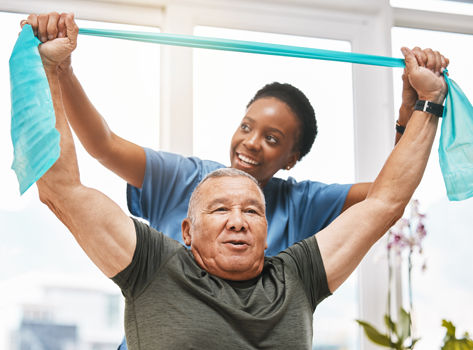
According to the U.S. Department of Health and Human Services, falls are the leading cause of broken bones and head injuries in older adults. They are also the reason for most emergency department visits by older adults.
Why is this, and how can you lower your risk of falling as you age?
Jennifer Krekel, PT, DPT, EdD, a physical therapist with Atlantic Health System, explains the role of your current health and environment on your fall risk. She offers two proactive strategies you can take to reduce or even prevent falls from happening.
The impact of muscle loss on older adults
Your age has a significant effect on how and how often you fall, the types of injuries you sustain and how well you recover. The reason has to do with your muscles.
By age 40, you begin to lose muscle mass at a rate of 1% per year and muscle function (or strength) at a rate of 3-4% per year. This age-related, involuntary loss of muscle mass and strength is called sarcopenia.
By the time you’re 65, you’ve lost anywhere from 8% to 27% of your muscle mass and function. The exact rate of your muscle decline is directly influenced by your lifestyle choices — things like diet, exercise, alcohol consumption and smoking — which means, you can take steps to slow it down.
To combat sarcopenia, Krekel recommends:
- engaging in resistance training (using weights, resistance bands or your own body weight) three times a week.
- increasing your daily protein intake to build muscle.
- supplementing with vitamin D to improve bone strength.
The role of health and environment in falls
According to a 2006 study, nearly half of all falls in older people are the result of three identifiable markers:
- Muscle weakness.
- Gait (walking) or balance disorders.
- Home hazards such as loose rugs, unstable furniture, poor lighting, clutter and a lack of assistive devices like grab rails and banisters.
In addition to sarcopenia, many age-related health conditions can impact your strength and balance, including osteoporosis (weak bones), osteoarthritis (joint disease), cardiovascular (heart) disease and orthostatic hypotension (low blood pressure). Slower reflexes and compromised spatial recognition due to a natural decline in your motor function, vision and hearing — as well as some cognitive diseases such as dementia and Alzheimer’s and even some medications — also can increase your risk of falling.
How to reduce fall risk
“Most falls are preventable,” says Krekel. “The first step is to identify environmental risks, then improve your strength, balance and coordination with exercise and assistive devices when needed. The best way to do that is by working with a physical therapist.”
Identify environmental risks
After evaluating your home for potential hazards, take the following steps to improve the safety of your environment:
- Add adequate lighting inside and out.
- Get rid of clutter and loose cords.
- Install bathroom grab rails, tub mats and raised toilet seats.
- Lower bed frames.
- Secure furniture with floor or wall anchors.
- Secure rugs and carpets to the floor.
- Tighten stairway banisters.
Also, always wear supportive footwear (not backless slippers) and properly use assistive devices when needed.
Work with a physical therapist to improve strength, balance and coordination
According to Krekel, “A combination of balance, strength and endurance training for a total of 150 minutes per week, per the American College of Sports Medicine guidelines for older adults, can substantially reduce the severity of disabilities associated with many age-related illnesses and even prevent falls.”
To determine which exercises are best for you, Krekel advises older adults get evaluated by a physical therapist (PT) who will use functional outcome tools like the TUG (Timed Up and Go) Assessment, Berg Balance Scale and Tinetti Balance and Gait Assessment to rate the following:
- Balance
- Eye-hand coordination
- Flexibility
- Gait
- Grip strength
- Mobility
- Overall strength
- Posture
- Reach and range of motion
With this information, your PT will work with you to devise a personalized exercise plan to increase your body strength, grow muscle, improve blood flow and enhance your balance. Atlantic Health also offers virtual classes such as Strength & Stretch and Better Bones for those who prefer to stay home.
But physical therapy is about more than just working up a sweat.
PTs also can teach you techniques to make everyday activities easier and safer. This includes tasks like getting in and out of the shower, carrying laundry up the stairs and bending to put on your shoes. Whether it’s using assistive devices like canes or walkers, or simply learning how to position your body before lifting a package, a PT can provide valuable tools to help you reduce your fall risk.
Key takeaways
Aging is inevitable, but falls don’t have to be. Taking proactive steps like working with a physical therapist to improve balance and build strength can slow the decline of age-related muscle loss and lower your risk for falling.
Be Proactive About Your Health
To stay safe and healthy, it's good to have a primary care provider who knows and understands your health history and wellness goals.